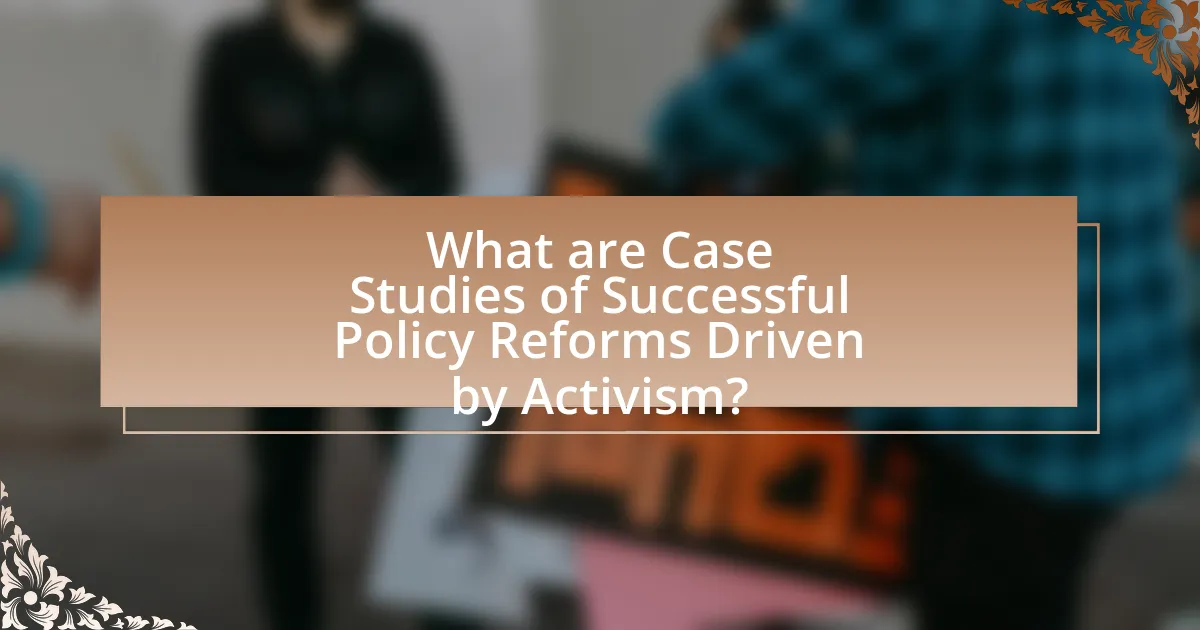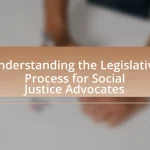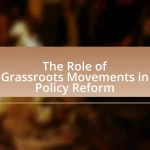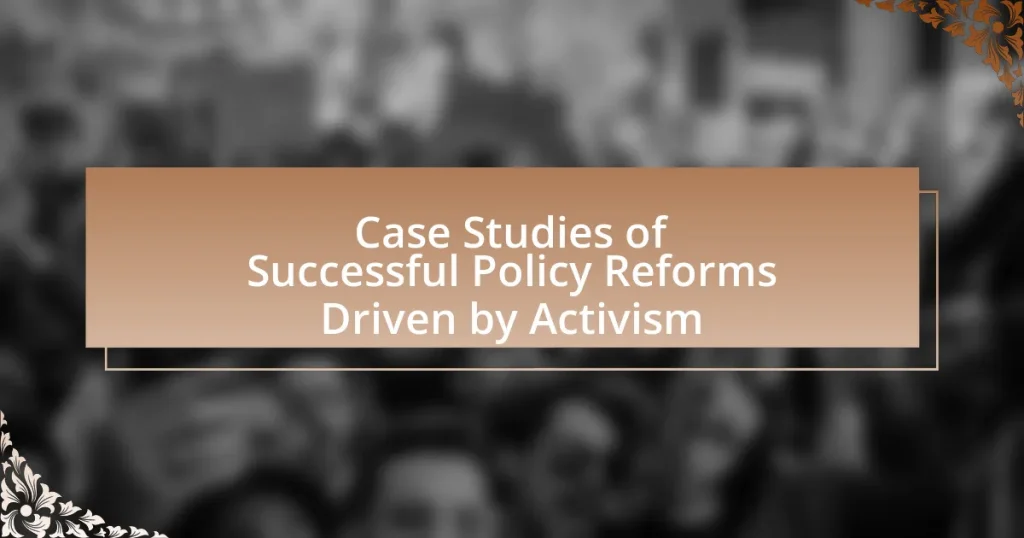The article examines case studies of successful policy reforms driven by activism, highlighting significant movements such as the Civil Rights Movement and environmental activism related to the Clean Air Act. It discusses how organized efforts, including protests and grassroots mobilization, have led to substantial legislative changes, emphasizing the importance of public engagement, coalition-building, and data-driven advocacy. The article also addresses the challenges activists face, such as political resistance and funding limitations, while outlining effective strategies and best practices for future activism efforts. Key factors contributing to successful reforms are identified, providing insights into the dynamics of activism and its impact on policy change.

What are Case Studies of Successful Policy Reforms Driven by Activism?
Case studies of successful policy reforms driven by activism include the Civil Rights Movement in the United States, which led to the passage of the Civil Rights Act of 1964, prohibiting discrimination based on race, color, religion, sex, or national origin. Activists organized protests, marches, and legal challenges that highlighted systemic injustices, ultimately influencing public opinion and legislative change. Another example is the environmental activism surrounding the Clean Air Act of 1970, where grassroots movements raised awareness about air pollution, leading to stricter regulations and improved air quality standards. These cases demonstrate how organized activism can effectively drive significant policy reforms.
How do these case studies illustrate the impact of activism on policy reforms?
These case studies illustrate the impact of activism on policy reforms by demonstrating how organized efforts can lead to significant legislative changes. For instance, the case of the Civil Rights Movement in the 1960s shows that sustained activism, including protests and advocacy, resulted in the passage of the Civil Rights Act of 1964, which outlawed discrimination based on race, color, religion, sex, or national origin. Similarly, the environmental activism surrounding the Clean Air Act of 1970 led to stricter air quality standards, showcasing how public pressure and grassroots mobilization can influence policymakers. These examples confirm that activism not only raises awareness but also directly contributes to shaping and enacting policy reforms.
What specific examples highlight successful outcomes from activism?
Successful outcomes from activism include the Civil Rights Movement, which led to the Civil Rights Act of 1964, prohibiting discrimination based on race, color, religion, sex, or national origin. This legislation was a direct result of organized protests, legal challenges, and advocacy by activists like Martin Luther King Jr. and organizations such as the NAACP. Another example is the environmental activism surrounding the Clean Air Act of 1970, which was influenced by grassroots movements and led to significant reductions in air pollution across the United States. These examples demonstrate how sustained activism can result in meaningful legislative changes that address social and environmental issues.
How do these examples differ in their approaches and contexts?
The examples differ in their approaches and contexts primarily through the specific strategies employed by activists and the socio-political environments in which they operate. For instance, one example may illustrate grassroots mobilization tactics aimed at local policy changes, while another might focus on national advocacy through lobbying and coalition-building. The context also varies, as one case may occur in a democratic setting with established channels for public input, whereas another might take place in an authoritarian regime where activists face significant repression. These differences highlight how the effectiveness of activism is influenced by both the methods chosen and the surrounding political landscape.
Why is it important to analyze these case studies?
Analyzing case studies of successful policy reforms driven by activism is crucial because they provide empirical evidence of effective strategies and outcomes. These case studies illustrate how grassroots movements can influence legislative changes, demonstrating the power of collective action. For instance, the Civil Rights Movement in the United States led to significant legal reforms, such as the Civil Rights Act of 1964, showcasing how organized activism can achieve substantial policy shifts. By studying these examples, policymakers and activists can identify best practices, understand the challenges faced, and replicate successful tactics in future movements.
What lessons can be learned from successful policy reforms?
Successful policy reforms demonstrate the importance of stakeholder engagement and evidence-based decision-making. Engaging diverse stakeholders, including affected communities and experts, fosters trust and ensures that reforms address real needs, as seen in the 2010 healthcare reform in Massachusetts, which involved extensive public consultation. Additionally, utilizing data and research to inform policy choices leads to more effective outcomes; for instance, the implementation of evidence-based practices in education reforms has shown significant improvements in student performance, as highlighted by the 2015 Every Student Succeeds Act. These lessons underscore that inclusive processes and reliance on empirical evidence are critical for the success of policy reforms.
How can these lessons be applied to future activism efforts?
Lessons from successful activism can be applied to future efforts by emphasizing strategic coalition-building, effective communication, and data-driven advocacy. For instance, the coalition formed during the Civil Rights Movement demonstrated that uniting diverse groups around a common goal can amplify impact, as seen in the passage of the Civil Rights Act of 1964. Additionally, the use of social media in recent movements, such as Black Lives Matter, illustrates how effective communication can mobilize support and raise awareness rapidly. Data-driven advocacy, exemplified by the environmental movement’s reliance on scientific research to support climate policy, shows that presenting concrete evidence can persuade policymakers and the public. These strategies, rooted in historical successes, provide a framework for future activism to achieve meaningful policy reforms.

What are the key factors that contribute to successful policy reforms driven by activism?
Successful policy reforms driven by activism are primarily influenced by strong public support, effective coalition-building, strategic communication, and the ability to leverage data and research. Strong public support mobilizes grassroots movements, as seen in the Civil Rights Movement, where widespread public backing led to significant legislative changes. Effective coalition-building among diverse groups enhances resource sharing and amplifies voices, exemplified by the Women’s March, which united various organizations to advocate for women’s rights. Strategic communication ensures that messages resonate with the public and policymakers, as demonstrated by the climate change activism led by organizations like Greenpeace, which effectively framed the issue to garner attention. Lastly, leveraging data and research provides credible evidence to support claims, as seen in the tobacco control movement, where studies linking smoking to health risks informed policy decisions. These factors collectively create an environment conducive to successful policy reforms.
How does public engagement influence policy reform outcomes?
Public engagement significantly influences policy reform outcomes by fostering greater accountability and responsiveness from policymakers. When citizens actively participate in the policymaking process, they can articulate their needs and preferences, which can lead to reforms that better reflect the public interest. For instance, the successful campaign for marriage equality in the United States demonstrated how public engagement through protests, social media, and grassroots organizing mobilized support and shifted public opinion, ultimately influencing the Supreme Court’s decision in Obergefell v. Hodges in 2015. This case exemplifies how sustained public advocacy can lead to substantial legal and policy changes, reinforcing the idea that engaged citizens can drive meaningful reform.
What role does grassroots mobilization play in these reforms?
Grassroots mobilization plays a crucial role in driving successful policy reforms by amplifying the voices of communities and fostering collective action. This form of mobilization enables individuals to organize, advocate, and influence decision-makers effectively, often leading to significant changes in policies that reflect the needs and desires of the populace. For instance, the Civil Rights Movement in the United States showcased how grassroots efforts, such as protests and community organizing, led to landmark legislation like the Civil Rights Act of 1964, which outlawed discrimination based on race, color, religion, sex, or national origin. This historical example illustrates that grassroots mobilization not only raises awareness but also creates pressure on policymakers to enact reforms that align with the demands of the community.
How do social media and technology facilitate activism?
Social media and technology facilitate activism by providing platforms for rapid communication, mobilization, and awareness-raising. These digital tools enable activists to share information instantly, organize events, and connect with like-minded individuals across the globe. For instance, the Arab Spring demonstrated how social media platforms like Twitter and Facebook were instrumental in organizing protests and disseminating information, leading to significant political changes in several countries. Additionally, studies show that campaigns utilizing social media can reach millions quickly; for example, the #MeToo movement gained widespread attention and support through social media, resulting in policy changes regarding sexual harassment in various organizations.
What strategies have proven effective in driving policy change?
Effective strategies for driving policy change include grassroots mobilization, coalition building, and leveraging data-driven advocacy. Grassroots mobilization engages community members to raise awareness and pressure policymakers, as seen in the Civil Rights Movement, where local activism led to significant legislative changes. Coalition building unites diverse groups to amplify voices and resources, exemplified by the successful collaboration of environmental organizations in the fight for climate policy reforms. Data-driven advocacy utilizes research and statistics to inform and persuade stakeholders, demonstrated by the use of health data in campaigns for tobacco regulation, which resulted in substantial policy shifts. These strategies have consistently proven effective in achieving meaningful policy reforms.
Which advocacy tactics yield the best results?
Direct lobbying and grassroots mobilization yield the best results in advocacy. Direct lobbying involves engaging with policymakers to influence legislation, which has proven effective in cases like the American Cancer Society’s successful lobbying for tobacco control laws. Grassroots mobilization, exemplified by movements such as the Women’s March, effectively raises public awareness and pressure on decision-makers, leading to significant policy changes. Research indicates that combining these tactics enhances overall impact, as seen in the successful passage of the Affordable Care Act, where both direct lobbying and grassroots efforts played crucial roles.
How do coalitions and partnerships enhance reform efforts?
Coalitions and partnerships enhance reform efforts by pooling resources, expertise, and influence to create a unified front for change. This collaborative approach allows diverse stakeholders, including non-profits, community organizations, and government entities, to leverage their strengths and address complex issues more effectively. For instance, the coalition formed for the Affordable Care Act in the United States combined the efforts of various health organizations, which significantly increased public support and facilitated the passage of the legislation. Research indicates that collaborative networks can lead to more innovative solutions and greater impact, as seen in successful environmental reforms where partnerships between local governments and advocacy groups resulted in significant policy changes.

What challenges do activists face in pursuing policy reforms?
Activists face significant challenges in pursuing policy reforms, including political resistance, limited resources, and public apathy. Political resistance often manifests through opposition from lawmakers or interest groups who may benefit from the status quo, making it difficult for activists to gain traction for their proposals. Limited resources, such as funding and manpower, hinder the ability of activists to effectively organize campaigns and mobilize support. Additionally, public apathy can impede progress, as a lack of awareness or interest in specific issues reduces pressure on policymakers to enact change. These challenges are well-documented in various case studies, illustrating the complex landscape activists navigate in their efforts to influence policy.
How do political and institutional barriers impact activism?
Political and institutional barriers significantly hinder activism by restricting access to decision-making processes and limiting the ability to mobilize support. These barriers can manifest as restrictive laws, bureaucratic red tape, or lack of institutional support, which can stifle grassroots movements and discourage public participation. For example, in many countries, laws regulating protests or requiring permits can create obstacles for activists, making it difficult to organize events or express dissent. Additionally, institutional resistance from government agencies can lead to a lack of responsiveness to activist demands, as seen in cases where public officials ignore petitions or fail to engage with community concerns. Such barriers not only diminish the effectiveness of activism but can also lead to disillusionment among supporters, ultimately impacting the success of policy reforms driven by these movements.
What are common obstacles encountered during reform efforts?
Common obstacles encountered during reform efforts include resistance from established interests, lack of political will, insufficient funding, and inadequate public support. Established interests often oppose reforms that threaten their power or resources, as seen in various healthcare and environmental policy changes. Lack of political will can stem from leaders prioritizing short-term gains over long-term benefits, which has been evident in numerous legislative initiatives. Insufficient funding can hinder the implementation of reforms, as demonstrated in education reform efforts that require substantial investment. Lastly, inadequate public support can undermine reform initiatives, as public opinion plays a crucial role in sustaining momentum for change.
How can activists overcome these challenges?
Activists can overcome challenges by employing strategic coalition-building, effective communication, and leveraging data-driven advocacy. Coalition-building allows activists to unite diverse groups, increasing their collective power and resources, as seen in the successful collaboration of environmental organizations during the Paris Agreement negotiations in 2015. Effective communication, including storytelling and social media engagement, helps activists convey their messages clearly and resonate with broader audiences, exemplified by the viral impact of the #MeToo movement. Additionally, leveraging data-driven advocacy enables activists to present compelling evidence to policymakers, as demonstrated by the use of research in the fight for gun control reforms, which has shown a correlation between stricter laws and reduced gun violence.
What role does funding play in successful activism?
Funding is crucial for successful activism as it enables organizations to mobilize resources, conduct outreach, and sustain campaigns. Financial support allows activists to hire staff, produce materials, and engage in strategic communication, which are essential for raising awareness and influencing public opinion. For instance, the American Civil Liberties Union (ACLU) has effectively utilized funding to challenge unconstitutional laws and advocate for civil rights, demonstrating that adequate financial backing can lead to significant legal victories and policy changes. Additionally, research indicates that well-funded movements, such as the environmental activism surrounding the Paris Agreement, have greater capacity to organize events, lobby policymakers, and create impactful media campaigns, ultimately leading to successful reforms.
How do financial resources affect the scale and impact of activism?
Financial resources significantly enhance the scale and impact of activism by enabling broader outreach, sustained campaigns, and strategic initiatives. For instance, organizations with substantial funding can mobilize larger volunteer bases, invest in advertising, and utilize advanced technology for communication and organization. A notable example is the American Civil Liberties Union (ACLU), which raised over $24 million in small donations during the 2016 election cycle, allowing it to expand its legal efforts and advocacy campaigns, thereby increasing its influence on policy reforms. This financial backing directly correlates with the ACLU’s ability to challenge legislation and defend civil rights effectively, demonstrating that adequate funding is crucial for maximizing the reach and effectiveness of activist movements.
What funding models support sustainable activism initiatives?
Diverse funding models support sustainable activism initiatives, including grants, crowdfunding, membership fees, and social enterprise revenue. Grants from foundations and government entities provide essential financial backing for long-term projects, while crowdfunding platforms enable grassroots support and community engagement. Membership fees create a steady income stream for organizations, fostering a sense of ownership among supporters. Additionally, social enterprises generate revenue through products or services aligned with their mission, ensuring financial sustainability. These models collectively enhance the capacity of activism initiatives to drive policy reforms effectively.
What practical tips can activists use to enhance their effectiveness?
Activists can enhance their effectiveness by employing strategic communication, building coalitions, and utilizing data-driven approaches. Strategic communication involves crafting clear, compelling messages that resonate with the target audience, which has been shown to increase engagement and support. For instance, the successful campaign for marriage equality in the United States utilized personal stories and relatable messaging to shift public opinion. Building coalitions with diverse groups amplifies voices and resources, as seen in the environmental movement where partnerships between various organizations have led to significant policy changes. Lastly, utilizing data-driven approaches allows activists to present compelling evidence that supports their cause, such as the use of statistics in campaigns to reduce gun violence, which helped to inform policy discussions and legislative actions.
How can activists build a strong community support base?
Activists can build a strong community support base by engaging in consistent outreach and fostering relationships with community members. This involves organizing events, conducting surveys to understand community needs, and creating platforms for dialogue. For instance, the Black Lives Matter movement effectively utilized social media to mobilize support and raise awareness, resulting in widespread participation in protests and community discussions. Research indicates that grassroots organizing, which includes door-to-door canvassing and local meetings, significantly increases community involvement and support, as seen in the successful campaigns for marriage equality in various states.
What best practices should be followed for effective advocacy campaigns?
Effective advocacy campaigns should prioritize clear messaging, strategic targeting, and coalition building. Clear messaging ensures that the campaign’s goals and values resonate with the audience, making it easier to mobilize support. Strategic targeting involves identifying key stakeholders and decision-makers who can influence policy outcomes, thereby maximizing the campaign’s impact. Coalition building fosters collaboration among diverse groups, enhancing resources and amplifying voices. Research indicates that campaigns with strong coalitions are more likely to achieve their objectives, as seen in the successful advocacy for the Affordable Care Act, which involved numerous organizations working together to influence public opinion and legislative action.










